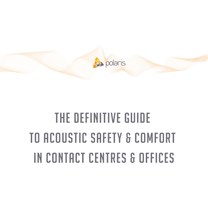An Acoustic Shock occurs when a headset user is exposed to a sudden and unexpected noise or high-pitched sound.
With the proliferation of contact centres in the late 1990s came a dramatic increase in the use of headsets, which are a major contributing factor in the incidence of acoustic shock syndrome. But what was traditionally a contact centre issue is now extending into the general office environment with the implementation of Softphone, VoIP and UC applications.
There are two types of hearing damage that can affect headset wearers:
1. Long Term Noise Exposure
Damage from long term noise exposure can occur when a headset wearer is continuously exposed to high levels of noise every day. Over time this may result in hearing loss.
2. Acoustic Shock Injury
Acoustic shock injury is more immediate and is completely unrelated to long term noise exposure. It is caused by an unexpected, sudden and usually high-pitched sound transmitted through the headset usually in the frequency range 1kHz - 4kHz. Using a headset increases the risk of dangerous exposure to high pitched sounds because a headset, unlike a traditional phone handpiece, cannot be dropped or quickly removed from the ear as soon as the noise is heard.
Acoustic Shock is not limited to any telephony equipment, platform, network or headset type. High pitched tones are random and often cannot be traced or prevented from recurring.
Simply being exposed to constant loud noise through a headset cannot cause acoustic shock. This may cause long term hearing damage, but not acoustic shock injury.
Examples of sounds that can cause acoustic shock injury:
-
IP network shrieks
-
Video Meetings – audible Ping as new members join
-
Power supply failures
-
Maliciously generated noises - screaming or blowing a whistle down the line.
-
Mobile phone interference.
-
Background noise (siren’s)
Effects of Acoustic Shock Injury
The effects of acoustic shock injury are both short term and long term:
Short term symptoms:
-
Headaches
-
Balance disturbances
-
Nausea
-
Pain (ear, head and neck)
Long term symptoms:
-
Hearing loss
-
Tinnitus (ringing in the ears)
-
Hypersensitivity to high level sounds
-
Stress
Current regulations regarding the prevention of acoustic shock injury are confusing and misleading because they do not address the issue adequately.
The Australian Communications Industry Forum (ACIF) G616:2013 Acoustic Safety for Telephone Equipment Guidelines recommends a headset output limit of 102dB, while in Europe the recommended limit for ‘peak sounds’ is 135dB.
However, limiting sound output does nothing to prevent acoustic shock injury. Acoustic shrieks can, and do, happen at low volumes because acoustic shock is a nervous system response to a ‘sudden and unexpected’ sound.
Acoustic Safety for your Workplace:
To date, the only headset products proven to eliminate the risk of acoustic shock injury are Polaris’ Soundshield 4G Acoustic Protection device, Soundshield Wireless Headset and HD Wireless Headset and the newest edition to the family is the new Soundshield Voice Acoustic Rejection Software for Windows 10 OS.
The Soundshield Story
Learn about the development of Polaris' revolutionary Soundshield products.








